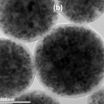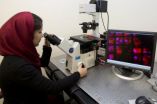(Press-News.org) Their study is published today (3rd March 2014) in the Journal of Clinical Investigation.
The research team have found that a plant pigment called quercetin – present in some fruits, vegetables, herbs and grains – could help to prevent damage to the nerves associated with the childhood form of motor neurone disease, spinal muscular atrophy (SMA).
SMA, also known as 'floppy baby syndrome', is a leading genetic cause of death in children. It affects approximately one in 6,000 to 10,000 children and around half of children with the most severe form will die before the age of two. There is currently no cure for this kind of neuromuscular disorder.
The condition is caused by a mutation in a gene that is vital for the survival of nerve cells that connect the brain and spinal cord to the muscles, known as motor neurons. Until now, it was not known how the mutation damages these cells and causes disease.
The study reveals that the mutated gene affects a key housekeeping process that is required for removing unwanted molecules from cells in the body. When this process doesn't work properly, molecules can build-up and cause problems inside the cells.
Children with SMA experience progressive muscle wastage and loss of mobility and control of their movements. The disorder is often referred to as 'floppy baby syndrome' because of the weakness that it creates.
The team has found that the build-up of a specific molecule inside cells – called beta-catenin – is responsible for some of the symptoms associated with the condition.
In tests on zebra fish, mice and fruit flies (the latter in Plymouth), scientists found that treating the disease with purified quercetin – which targets beta-catenin – led to a significant improvement in the health of nerve and muscle cells.
Although quercetin did not prevent all of the symptoms associated with SMA, researchers hope that it could offer a useful treatment option in the early stages of disease. The team now hopes to create better versions of the chemical that are more effective than naturally-occurring quercetin.
Professor Tom Gillingwater from the University of Edinburgh, who led the study, said: "This is an important step that could one day improve quality of life for the babies affected by this condition and their families. There is currently no cure for this kind of neuromuscular disorder so new treatments that can tackle the progression of disease are urgently needed."
Dr. Iain Robinson, Associate Professor in Neuroscience at Plymouth University Peninsula Schools of Medicine and Dentistry, added: "By working to understand how SMA operates at a molecular level we have been able to apply a naturally occurring compound which targets the one of the key culprits, with the potential to introduce an effective drug therapy for children in the early stages of the disease."
INFORMATION: END
Plant extract hope for infant muscle disease
2014-03-04
ELSE PRESS RELEASES FROM THIS DATE:
Researchers develop antibody-targeted treatment for recurrent small-cell lung cancer
2014-03-04
Researchers at Norris Cotton Cancer Center have found an antibody that may be used in future treatments for recurrent small-cell lung cancer, which currently has no effective therapy. The mouse monoclonal antibody they have developed, MAG-1, targets the ProAVP surface marker. When given alone, it significantly slows the growth of tumor xenografts of human recurrent small-cell lung cancer in mice. The study, "Growth Impairment of Small-Cell Cancer by Targeting Pro-Vasopressin with MAG-1 Antibody," was recently published online in Frontiers in Oncology.
"We are developing ...
JCI online ahead of print table of contents for March 3, 2014
2014-03-04
Identification of factors that influence breast cancer metastasis to bone
One of the more serious and frequent complications of advanced breast cancer is bone metastasis, which is exacerbated by TGF-β signaling; however, it is not clear how TGF-β production is regulated prior to and during metastasis. In this issue of the Journal of Clinical Investigation, Guohong Hu and colleagues at the Shanghai Institutes for Biological Sciences evaluated murine models of invasive breast cancer and determined that cancer cells lacking the putative tumor suppressor DLC1 have ...
Youngest kindergarteners most likely to be held back, MU study finds
2014-03-04
COLUMBIA, Mo. -- For some parents, the decision of when to enroll their children into kindergarten can result in costly consequences such as another year of daycare expenses. In general, children must be five years old to be eligible to be enrolled in kindergarten. However, the developmental differences between a young kindergartener who barely qualifies for the state-mandated age cutoff date compared to a child who is almost year older, may have implications. Now, a University of Missouri researcher has found that the youngest kindergartners are about five times more likely ...
UC research tests which nano system works best in killing cancer cells
2014-03-04
In current research related to improving cancer treatments, one promising area of research is the effort to find ways to selectively pinpoint and target cancer cells while minimizing effects on healthy cells.
In that effort, it's already been found in lab experiments that iron-oxide nanoparticles, when heated and then applied specifically to cancer cells, can kill those cells because cancer cells are particularly susceptible to changes in temperature. Increasing the temperature of cancer cells to over 43 degrees Celsius (about 109 degrees Fahrenheit) for a sufficient ...
The chemistry (and fascinating history) of pepper, the spice that changed the world
2014-03-04
WASHINGTON, March 3, 2014 — Pepper is one of the most plentiful condiments in the world today, but it used to be more valuable than gold. In the American Chemical Society's (ACS') latest Reactions video, we examine how pepper's delectable chemistry made it a key player in the global spice trade. The sought-after spice helped usher in the "Age of Discovery," which bridged the gap between the Middle Ages and the Modern era. And because we're celebrating our second month of existence, it's a Reactions double feature this week. In our second video, we examine the science behind ...
Team models photosynthesis and finds room for improvement
2014-03-04
CHAMPAIGN, Ill. — Teaching crop plants to concentrate carbon dioxide in their leaves could increase photosynthetic efficiency by 60 percent and yields by as much as 40 percent, researchers report in a new study.
The team used a computer model to simulate how adding genes from a type of photosynthetic algae known as cyanobacteria might influence photosynthetic efficiency in plants. Cyanobacteria contain small structures, called carboxysomes, which concentrate carbon dioxide at the site of photosynthesis.
"Photosynthesis is the most studied of all plant processes, so ...
Scientists identify protein linked to most common movement disorder
2014-03-04
Quebec City, March 3rd, 2014—A team of researchers from Université Laval and CHU de Québec identified unusually high levels of a certain protein in the brains of people suffering from essential tremor (ET), a movement disorder that affects 4% of the adult population. The discovery, the details of which were published in the most recent edition of the journal Movement Disorders, could lead to an effective treatment for this neurological condition, which is 10 times more prevalent than Parkinson's disease.
As its name suggests, ET causes tremors in various parts of the ...
UC research tests range of electrical frequencies that help heal chronic wounds
2014-03-04
Naturally occurring electricity in our cells is key to how our bodies function, and that includes the healing of wounds.
And externally applied low-amplitude electric fields have been shown to help hard-to-heal chronic wounds, like those associated with diabetes, where there is insufficient blood supply and drug treatments are not effective. The externally applied electric field manipulates the body's naturally occurring electricity, such that the new vessels are formed, and blood supply to the wound is increased.
University of Cincinnati physics and biomedical engineering ...
Cigarette smoking may cause physical changes in brains of young smokers, UCLA study shows
2014-03-04
The young, it turns out, smoke more than any other age group in America. Unfortunately, the period of life ranging from late adolescence to early adulthood is also a time when the brain is still developing.
Now, a small study from UCLA suggests a disturbing effect: Young adult smokers may experience changes in the structures of their brains due to cigarette smoking, dependence and craving. Even worse, these changes can occur in those who have been smoking for relatively short time. Finally, the study suggests that neurobiological changes that may result from smoking ...
Pitt public health analysis provides guidance on hospital community benefit programs
2014-03-04
PITTSBURGH, March 3, 2014 – A new analysis led by the University of Pittsburgh Graduate School of Public Health offers insights for nonprofit hospitals in implementing community health improvement programs.
In a special issue of the Journal of Health Care for the Poor and Underserved that focuses on the Affordable Care Act (ACA), a multidisciplinary team of Pitt researchers explore published research on existing community benefit programs at U.S. hospitals and explain how rigorous implementation of such programs could help hospitals both meet federal requirements and ...



